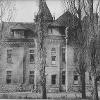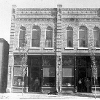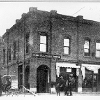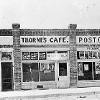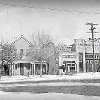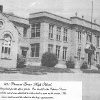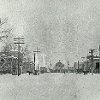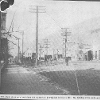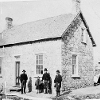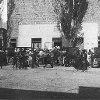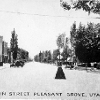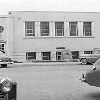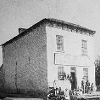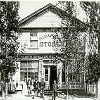
Pleasant Grove History
Like many of the communities in Utah, Pleasant Grove was settled by the Mormon pioneers.
These early settlers were sent by Brigham Young, thus establishing the small community September 13, 1850. The pioneers were attracted by a small grove of trees which gave promise and hope of a land with water and rich soil. The official name "Pleasant Grove" didn't come first although the name was based on the small grove of trees that were here when they first arrived. The first name of this community was "Battlecreek", named after the first skirmish in Utah between the Indians and pioneers, located in the mouth of the canyon above this small community.
Because of the Indian conflicts, the settlers were instructed to build a fort for protection. A meeting house and school house were then constructed to meet the spiritual and educational needs of the people who came to Pleasant Grove.
On January 19, 1855, the territorial legislature approved Pleasant Grove to become incorporated. The first municipal election was then held in May 1855 and Henson Walker took office as the first Mayor.
Nicknames began popping up that described certain areas of the community: "Little Denmark" was the area where Scandinavian people settled: "Monkey Town" was named because the youth gathered on "fog" corner in the area and "monkeyed" around which caused adults great concern over the "...mischievousness of the youth." "Mud Hole" was an area where the community's merchandising and entertainment occurred. It was said that the "upper class" lived in this area.
Life was difficult.
The settlers were terrified of the Indians but also had to face famine and hunger. They had to rely on one another to survive a few winters. The meeting house was also used as a storehouse but a fire brought the building and it's contents to the ground and there just wasn't enough time to re-stock before winter came on again.
Life wasn't all filled with hardships, however, people often met socially and because of the abundant strawberry crop every summer, "Strawberry Days" was created. Strawberry Days is the longest continuing community celebration in Utah to date.
The strawberry fields are now gone, taken over by development. The school house still stands and has been converted into a very nice pioneer museum to remind us of those who came first, those who were willing to take the risk, make their homes in a relatively unknown wilderness and to prepare the way for those who came after.
More History
The Timpanogos Indians in Utah Valley appeared friendly toward the Mormons when first the Anglo Americans intruded upon traditional Indian lands. However during the second winter of the Mormons' settlement in the Salt Lake Valley Oliver Boardman Huntington encountered hostile Indians when he traveled through Utah Valley in 1849. Defiance and mistrust were shown Huntington by Roman Nose, his brother Blue-shirt and two other native brothers.
Little Chief a noted Indian friend of the Mormons reported to Huntington that he had driven Roman Nose and his family away from his village of two hundred natives at the south of Utah Lake for ignoring his counsel to stop stealing Mormon cattle. Little Chief wanted Huntington to "Tell the big 'Yabaloo Captain' [white captain] to come up and kill them mean Ewtes" who had lived on stolen cattle all winter. He threatened to kill them himself if the whites did not, but thought it would look better for the whites to kill their enemies. The chief feared that if the thieving Indians were not stopped, the white man's retribution would be taken out on his own band.
Upon Huntington's return to Salt Lake City he conveyed Little Chiefs report to President Brigham Young, the Mormon Prophet. Indians had taken at least fourteen head of cattle from Willow Creek (Draper). These were not the first to be stolen. President Young gave orders to organize a company of fifty men to track down the thieving band. The Militia had not yet organized since the pioneers moved west. Young called fifty men to look into the matter. He placed the thirty- five who responded, counting those picked up in south Salt Lake County, under the command of John Scott.
Early in the morning of 1 March a herd of horses arrived from the Tooele Valley herd grounds to be used by the men. The company left Cottonwood at midday and camped near the next Cottonwood Canyon in Salt Lake County. They overlaid a blanket of snow with willows and brush and tried to sleep. "The night was very cold and the wind penetrating under our bed through the brush rendered our situation very uncomfortable," complained Hosea Stout. Their horses lacked forage. They arose early and traveled to Big Cottonwood and finding grass for the horses there, they also refreshed themselves with breakfast. By evening they reached Willow Creek (Draper) where the Indians had stolen cattle from wintering herds. The men killed a beef from the public herd to bolster their meager food supplies and left the responsibility of paying for the needed animals to those who had been called to go on the expedition but failed to respond. (Parley P. Pratt, to whom the beef belonged, later received compensation from the public fund.) The following evening the group camped at the Jordan Narrows. On 3 March they entered Utah Valley through the Narrows, then divided into three groups, and spent the cold, snowy day searching for the renegade Indians without success. The groups met and spent the night on the American River (American Fork River). When they awoke on 4 March a two-inch blanket of snow covered them.
Dimick Huntington (brother of O. B. Huntington) and Barney Ward, acting as interpreters, left for Little Chiefs camp at the south of Utah Lake to prepare the natives for the larger group's arrival. After spending the day searching, the divided groups met and rode on to join the two men at the lake. Another band of Indians led by Stick-in-the-head had been observed camping across the Provo River from Little Chiefs camp of about 200 natives. The Mormon group intended to camp that night three miles up the Provo River, but Little Chief encouraged them to move toward the mountains under cover of darkness so they would not be visible from the mountain retreat of Roman Nose and his band. The chief also feared that Stick-in-the-head would ride ahead of the Mormons and warn Roman Nose of the approaching group.
Two of Little Chiefs sons joined the men an hour after dark to serve as guides, and they traveled together toward the mountains through the cold, moonlit night. Ascending the high bench land they traveled north. The Indian scouts thought it best to leave the horses in a cedar grove with some of the men, who then built a fire to fend off the cold and bedded down for some rest.
Commander Scott with a scouting party proceeded on foot with one of the Indian guides. In the middle of the night they spotted three Indian huts. "Our Indian pilot, when he saw the fires of those we sought, his heart failed and he wished to go back saying he did not want to see them die, but at the same time desired us to kill them."
Three hours later Judson Stoddard, one of the advanced party often, returned to the resting detachment bearing orders to bring up the entire group in silence. They moved six miles over the spurs of the mountains to a deep ravine about one-half mile from the Indian's camp and "waited in silent suspense and anxiety for daylight."
The Indians had strategically located their camp in "a stronghold, a great place of defense. About one-fourth mile from the abrupt and almost inaccessible mountains, on the bank of a small creek, running swiftly down a very steep ravine filled with almost impenetrable small timber, brush and thorns. Their retreat could not be discerned in the daytime until within five rod of it."
The men divided into four squads and moved before daybreak, Monday 5 March, to three separate positions surrounding the camp and the fourth group mounted their horses and stayed below the creek in case the Indians escaped. One tardy division made a noise while crossing the creek and awoke the encamped Indians who immediately tried all directions looking to escape. Finding themselves surrounded, they threatened to fire upon their intruders if not released. Interpreters asked the surrounded natives to give up; they refused. With a "war hoop" the Indians fired arrows and three guns. Under orders that every man should take care of himself and as many of the enemy as he could, the Mormon company fired back. Roman Nose was killed and several others wounded. Howling noises of sorrow arose from the camp such that "white men never heard before."
The Indians took shelter in the creek that had perpendicular banks about four feet high thickly set with willows that completely hid them. The Mormons surrounding the site could not see their enemies until they raised up to shoot. The skirmish went on two more hours with several interruptions when the interpreters tried to persuade the band to give up or at least send out the women and children.
Meanwhile Stick-in-the-head with his sympathetic group of Indians perched above the fight on higher ledges. From that vantage point the renegade group tried to direct the escape of the surrounded Indians, vainly calling to them. When the Indians' arrows were nearly exhausted and the Mormons had almost all moved to one side of the creek some of the Indians began to run up the creek. Blue-shirt who nearly succeeded in getting away, fell with eighteen balls in his body. When he fell "he was running at the speed of a horse." Two other braves fell mortally wounded while running. Dimick Huntington called for the rest to surrender. An old Indian woman slowly ascended the bank of the stream. They persuaded her to surrender a gun and a brave of seventeen. Thirteen women and children came out having been crouched in the cold mountain stream over an hour. Two women had wounds on their heads from stones thrown into the bushes by the Mormons to rout them out. None of the Mormons had been injured.
That morning the sun rose before the shooting ceased. Little Chief, hearing the death knell of the gun volleys echoing across the valley, grieved for his people, although "a few hours previous he had signed their death warrant by sending his men to guide us to them, without which we could never have got them," wrote Huntington. Little Chief and his men rode swiftly the ten miles to the scene. His horse "was as wet [with sweat] as the poor squaws who had laid in the creek," and "Little Chief was wet with tears." The old chief "howled, cried, moaned, hollowed, and smote his breast in the greatest agony of mind. ...He blamed himself and cursed the whites." With mixed emotions he indicating that the "lad" should also have been killed for "he would kill a white man yet for revenge."
After charging the Mormons with the responsibility of caring for the widowed women and the fatherless children, Little Chief received presents from the Mormons. With the gifts came the assurance that the Mormons remained friends with the Indians explaining that they only killed the renegades to stop the stealing of cattle. The men found fifteen cattle hides and dried beef in Roman Nose's abandoned camp.
John Scott returned to the battleground to confer with the native women, "but found they had fled and took three of their dead up the canyon." Anxious to get home, the men traveled north camping the night of 6 March again on the American River. The Indian women and children eventually followed the men to the Salt Lake Valley where the Mormon community fed and cared for them until they chose to leave with Indian friends.
The battle area, the canyon and the stream where the skirmish occurred, known to the Indians as "Mepah," meaning Little Water, was renamed Battle Creek by the Mormons. Only a few of the early settlers had participated in this first Utah Territorial Mormon encounter with the Indians. In the fall of 1850 pioneers settlers stopped to make their homes in the valley directly below Battle Creek. For a short time the settlement took on the name of the battle scene.

